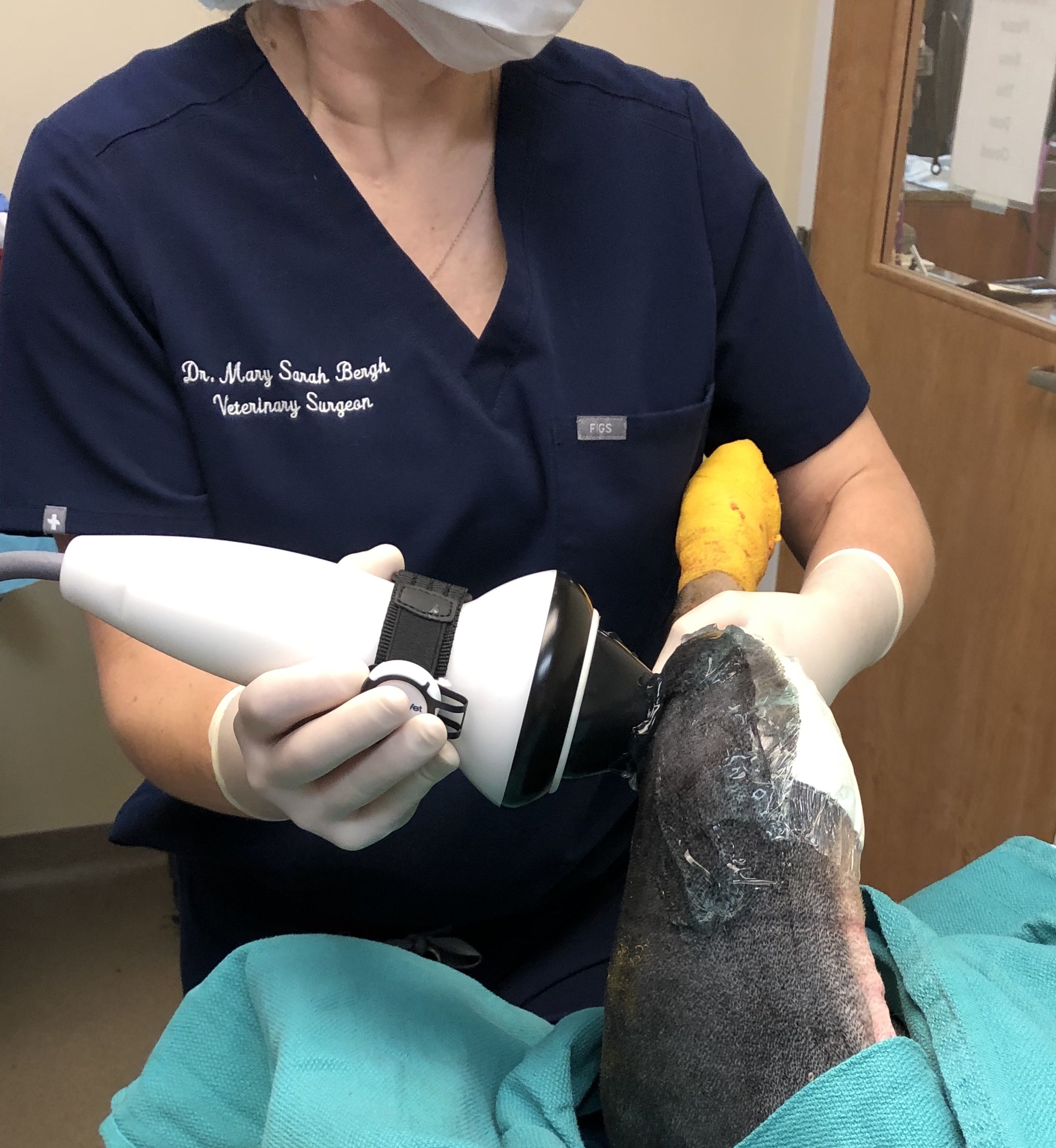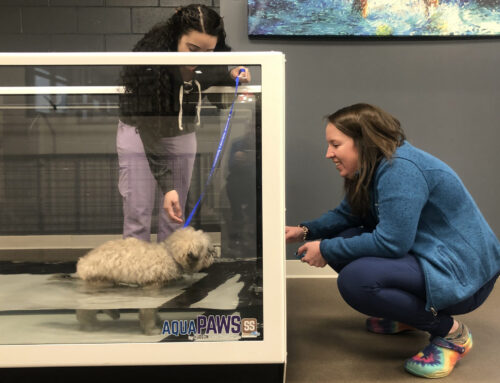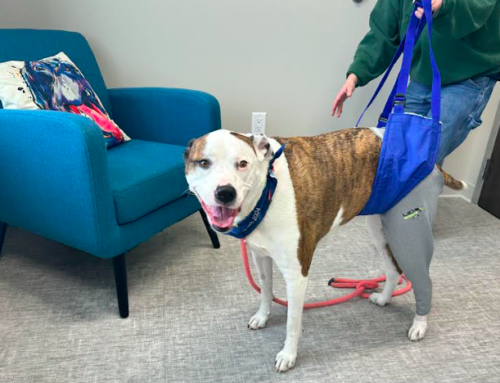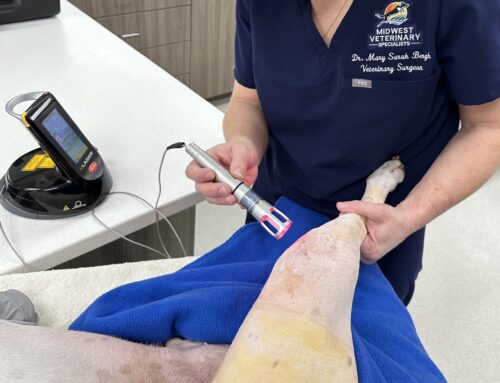Shockwave therapy is a noninvasive, drug-free treatment for pets experiencing pain and lameness. The technology employs focused high-energy sound waves to stimulate the body’s healing, regeneration, and pain relieving processes. These sound waves penetrate deeper and release more energy than ultrasound or laser therapy. Our team at Midwest Veterinary Specialists provides information about this treatment modality to help you determine if your pet could benefit from a shockwave session.
The history of shockwave therapy in pets
Extracorporeal shockwave therapy (ESWT) was first introduced in human clinical practice in 1982 for managing urologic conditions. The technology quickly became known as a non-invasive, effective method for urinary stone treatment. Further research demonstrated that ESWT was beneficial in fracture healing and tendon injury treatment, as well as other soft tissue conditions. ESWT is FDA-approved in humans, and in the 1990s, veterinarians began exploring ESWT for horses to help heal fractures, treat tendon and ligament injuries, and alleviate arthritis pain. In 1999, several major university veterinary schools became involved in researching ESWT treatment in dogs. Promising results indicate that ESWT is a valuable treatment for numerous orthopedic conditions in pets.
How shockwave therapy works in pets
High-energy, focused sound waves, also known as pulses, travel through soft tissue at customized depths to reach the area that needs treatment. Energy is released as the shockwaves interact with tissues, activating the body’s repair system. Effects include:
- New blood vessel formation — When tissue damage occurs, nutrient blood flow is necessary to start and maintain the repair process. ESWT creates capillary micro ruptures in tendon and bone, stimulating new blood vessel formation to support faster tendon and bone healing.
- Chronic inflammation reduction — Chronic inflammation occurs when acute tissue damage is not appropriately managed. Mast cells are key components in the inflammatory process, and ESWT likely increases mast cell activity. Once mast cells are activated, pro-inflammatory compounds, including chemokines and cytokines, are produced, and they help restore the normal healing and regenerative process.
- Increased collagen production — Sufficient collagen is necessary for healing damaged myoskeletal and ligamentous structures. ESWT accelerates procollagen synthesis and forces the new collagen fibers to orient longitudinally, which makes the healing tendon fibers more dense and creates a firmer structure.
- Calcification dissolution — Calcium buildup often results from micro tears to a tendon, preventing proper healing. ESWT breaks up these calcifications, which the lymphatic system removes.
- Decreased substance P concentrations — Substance P is a neurotransmitter that is generally associated with intense, persistent pain. ESWT lowers substance P concentrations, decreasing nociceptive fiber stimulation, and reducing pain.
Conditions in pets treated by shockwave therapy
Clinical research is ongoing to determine how pets can benefit from shockwave therapy. Currently, the evidence supports shockwave therapy treatments for horses and dogs, for conditions such as tendon and ligament injuries, bone and wound healing, osteoarthritis, and chronic pain. Specific applications include:
- Osteoarthritis — Pets are commonly affected by osteoarthritis, which causes significant pain and discomfort. Approximately one in five dogs are affected by arthritis, and studies have demonstrated that 60% to 90% of cats have some degree of arthritis visible on X-rays. ESWT reduces inflammatory cells inside the joint and decreases cartilage degradation to manage pain and slow disease progression. ESWT has been shown to be as effective as non-steroidal anti-inflammatory drugs (NSAIDs) for the treatment of elbow osteoarthritis in dogs.
- TPLO – Shockwave therapy has been shown to speed bone healing, increase limb use, and decrease patellar tendon inflammation following TPLO surgery for CCL rupture in dogs.
- Back pain — ESWT effectively treats some forms of back pain. One study demonstrated that 87% of pet patients had a positive outcome, and 77% showed results in one week.
- Fractures — Studies have demonstrated that ESWT helps bone heal faster and is especially useful in helping delayed and non-union fractures. ESWT led to significantly greater callus formation and increased cortical bone development.
- Tendon and ligament injuries — ESWT reduces the pain that accompanies tendon and ligament injuries, such as cranial cruciate ligament rupture, supraspinatus tenosynovitis, and biceps and Achilles tendon injuries, and can promote tendon and ligament healing and improve functionality.
- Chronic wounds — ESWT is approved to treat diabetic ulcers in humans and has been shown to improve skin flap healing.
- Joint injuries — Injuries affecting a pet’s hip, elbow, stifle, and shoulder can benefit from ESWT.
Shockwave therapy protocol in pets
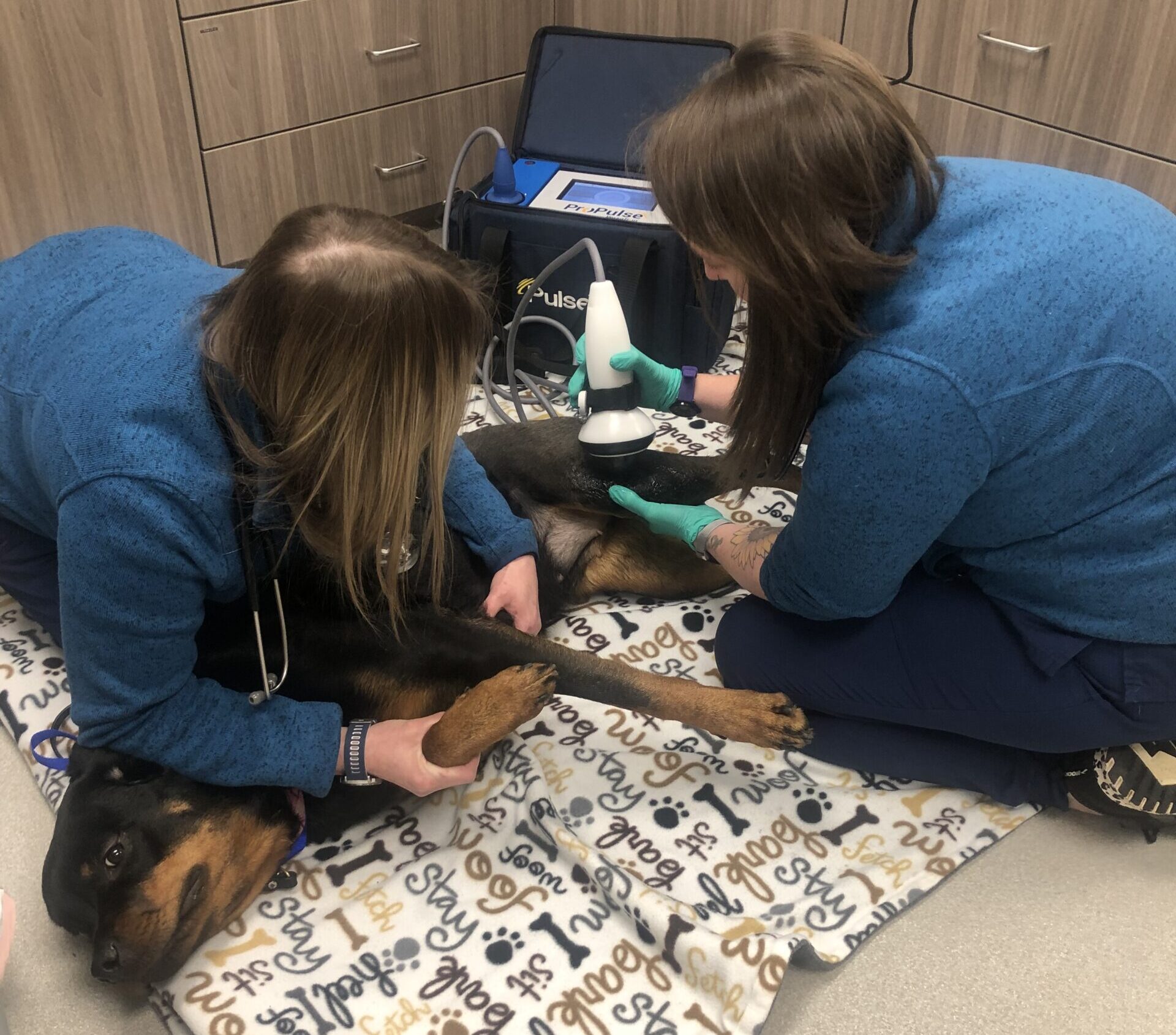
The shockwave probe is held against the treatment area for about five minutes per site. For optimal energy transmission, ultrasound gel is applied to the pet’s skin, and pets who have a thick hair coat may need their hair clipped. Historically, shockwave therapy was loud and painful and most pets needed sedation or anesthesia to tolerate it. At Midwest Veterinary Specialists, we have the newest technology—PulseVet Propulse Shockwave therapy—that focuses the sound energy differently and most pets tolerate the treatment well without sedation or anesthesia. Depending on the specific condition, pets usually need one to three treatments, spaced two to three weeks apart. No major adverse effects of ESWT have been reported.
More than 20 years of published clinical research proves that shock wave therapy is safe and effective. If you think your pet can benefit from shockwave therapy, contact our Midwest Veterinary Specialists team, so we can formulate an appropriate treatment plan.


